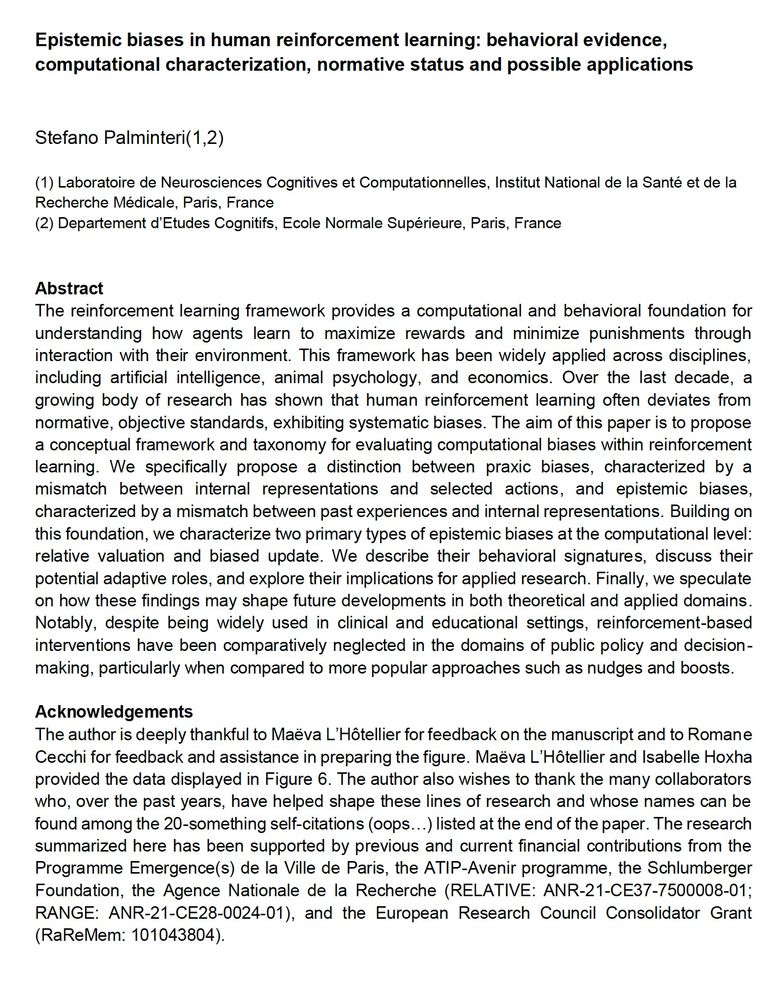Thanks for the kind mention @nclairis.bsky.social ! And congrats to the authors – really interesting to see mood being explored across species
30.04.2025 17:18 — 👍 2 🔁 0 💬 0 📌 0
OSF
9/9 🙌 Huge thanks to @sgluth.bsky.social & @stepalminteri.bsky.social!
📄 Read the full preprint: doi.org/10.31234/osf...
💬 Feedback and discussion welcome!
#reinforcementlearning #attention #computationalneuroscience #eyetracking
🧵/end
22.04.2025 16:57 — 👍 4 🔁 0 💬 0 📌 0
8/9 🎯 Conclusion
Attention doesn’t just follow value – it shapes it.
We showed that:
👁️ Gaze during learning causally biases value encoding
⏱️ Stimulus-directed attention sets the stage for processing the outcomes
🧩 Our model offers a mechanistic account of why mid-value options are undervalued in RL
22.04.2025 16:57 — 👍 1 🔁 0 💬 1 📌 0

7/9 ⏱️ When does attention matter?
🏆 Best fit? The stimulus-only model – consistent across experiments.
➕ Complemented by fine-grained gaze analysis:
👉 Value computation relies mainly on fixations during stimulus presentation, with minimal contribution from outcome-related fixations.
22.04.2025 16:57 — 👍 1 🔁 0 💬 1 📌 0
6/9 🧩 Modeling attention in value learning
We formalized these findings in an attentional range model, where visual fixations modulate absolute value before range normalization.
We tested 3 versions using:
• Only stimulus fixations
• Only outcome fixations
• A weighted combination
22.04.2025 16:57 — 👍 2 🔁 0 💬 1 📌 0

5/9 ⬆️ Exp 2 & 3: Bottom-up manipulation
We used saliency to guide gaze to the mid-value option:
• Exp 2: Salient stimulus → higher valuation in transfer
• Exp 3: Salient outcome → no significant effect
👉 Only attention to stimuli during learning influenced value formation
22.04.2025 16:57 — 👍 1 🔁 0 💬 1 📌 0

4/9 ⬇️ Exp 1: Top-down manipulation
We made the high-value option unavailable on some trials – forcing attention to the mid-value one.
Result: participants looked more at the mid-value option – and later valued it more.
👉 Attention during learning altered subjective valuation.
22.04.2025 16:57 — 👍 1 🔁 0 💬 1 📌 0

3/9 Design
We ran 3️⃣ eye-tracking RL experiments, combining:
• A 3-option learning phase with full feedback
• A transfer test probing generalization & subjective valuation
Crucially, we manipulated attention via:
• Top-down control (Exp 1)
• Bottom-up saliency (Exp 2 & 3)
22.04.2025 16:57 — 👍 1 🔁 0 💬 1 📌 0
2/9 💡 Hypothesis
Could attention be the missing piece?
Inspired by the work of @krajbichlab.bsky.social, @yaelniv.bsky.social, @thorstenpachur.bsky.social and others, we asked:
👉 Does where we look during learning causally shape how we encode value?
22.04.2025 16:57 — 👍 2 🔁 0 💬 1 📌 0

1/9 🎨 Background
When choosing, people don’t evaluate options in isolation – they normalize values to context.
This holds in RL... but in three-option settings, people undervalue the mid-value option – something prior models fail to explain (see @sophiebavard.bsky.social).
❓Why the distortion?
22.04.2025 16:57 — 👍 1 🔁 0 💬 1 📌 0
OSF
🧵 New preprint out!
📄 "Elucidating attentional mechanisms underlying value normalization in human reinforcement learning"
👁️ We show that visual attention during learning causally shapes how values are encoded
w/ @sgluth.bsky.social & @stepalminteri.bsky.social
🔗 doi.org/10.31234/osf...
22.04.2025 16:57 — 👍 15 🔁 6 💬 1 📌 1

Epistemic biases in human reinforcement learning: behavioral evidence, computational characterization, normative status and possible applications.
A quite self-centered review, but with a broad introduction and conclusions and very cool figures.
Few main takes will follow
osf.io/preprints/ps...
23.01.2025 15:47 — 👍 38 🔁 19 💬 1 📌 0
New preprint! 🚨
Performance of standard reinforcement learning (RL) algorithms depends on the scale of the rewards they aim to maximize.
Inspired by human cognitive processes, we leverage a cognitive bias to develop scale-invariant RL algorithms: reward range normalization.
Curious? Have a read!👇
10.12.2024 18:02 — 👍 14 🔁 7 💬 1 📌 1
OSF
🚨New preprint alert!🚨
Achieving Scale-Invariant Reinforcement Learning Performance with Reward Range Normalization.
Where we show that things we discover in psychology can be useful for machine learning.
By the amazing
@maevalhotellier.bsky.social and Jeremy Perez.
doi.org/10.31234/osf...
05.12.2024 15:22 — 👍 23 🔁 10 💬 1 📌 0
PhD student in Cognitive Sciences with Maël Lebreton - Paris School of Economics & École Normale Supérieure
💭 Looking at #decisionmaking #reinforcementlearning #confirmationbias #metacognition
Professor of Computational Neuroscience, Technical University of Munich, Germany
mls.ls.tum.de/compneuro/
Professor in Computational Neuroscience at Imperial College London
sensorimotor computations, beta bursts, laminar MEG, infant development 🧠🦾💥🍰👶
PI: James Bonaiuto
www.danclab.com
Natural and artificial general intelligence.
https://marcelbinz.github.io/
Machine learning, interpretability, visualization, Language Models, People+AI research
asst prof @Stanford linguistics | director of social interaction lab 🌱 | bluskies about computational cognitive science & language
Computational neuroscientist at Sorbonne University, Paris. Interests at the intersection of cognition, motor control, and their circuits.
heikestein.github.io
INSERM group leader @ Neuromodulation Institute and NeuroSpin (Paris) in computational neuroscience.
How and why are computations enabling cognition distributed across the brain?
Expect neuroscience and ML content.
jbarbosa.org
Professor for Cognitive Modelling & Decision Neuroscience (@cmdn-lab.bsky.social) at the University of Hamburg (@uni-hamburg.de). Interested in raising two kids, bouldering, football, and other things (if time permits).
Cognitive Science postdoc. University of Geneva. Ex-HRL team (DEC, ENS, Paris)
human behavior/reinforcement learning/decision-making/computational modeling
UCLA Psychology lab that studies Neuroeconomics, Decision Psychology/Neuroscience, Cognitive Psychology/Neuroscience/Economics, etc. We specialize in combining mathematical models with choice-process measures.
PhD Student at the Paris Brain Institute | Creativity, Decision, Affects & Computational modelling
🔗 https://sites.google.com/view/frontlab-icm/people/phd-students/gino-battistello
Cognitive computational (neuro-)science PhD student at Uni Tübingen 🧠🤖 she/her
Interested in how brains make decisions and maintain motivation over time. All opinions expressed are my personal ones.
websites:
https://sites.google.com/view/ecc-team/home
Neuroscientist, systems science for neuroscience, neural interactions, human learning
https://brovelli.github.io/
https://www.youtube.com/@brovelli
Postdoc passionate about effort-based decision-making and the roots of effort aversiveness.
If you are on Mastodon, my profile is: @nicolasclairis@fediscience.org
She/her
PhD student in the Human Reinforcement Learning team
Laboratoire de Neurosciences Cognitives Computationnelles
Ecole Normale Supérieure (ENS), Paris, France





